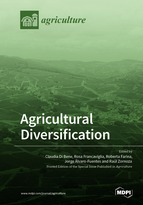Agricultural Diversification
A special issue of Agriculture (ISSN 2077-0472). This special issue belongs to the section "Agricultural Systems and Management".
Deadline for manuscript submissions: closed (20 February 2021) | Viewed by 60590
Special Issue Editors
Interests: climate change adaptation and mitigation; cropping systems diversification, simulation modelling; water use efficiency
Special Issues, Collections and Topics in MDPI journals
Interests: soil organic carbon content; soil fertility; soil biodiversity; land-use/land-cover change; SOC simulation models
Special Issues, Collections and Topics in MDPI journals
Interests: sustainable agriculture; agricultural soils; biophysical models; soil organic carbon; sustainability indicators
Special Issues, Collections and Topics in MDPI journals
Interests: agronomy; soil sciences; crop diversification; climate change; soil fertility; soil organic carbon; conservation agriculture; no-tillage; greenhouse gas; ecosystem management
Special Issues, Collections and Topics in MDPI journals
Interests: soil quality; soil recovery; soil reclamation; organic matter characterization and dynamics
Special Issue Information
Dear Colleagues,
Agricultural diversification can occur in many forms (e.g., genetic variety, species, structural) and can be created temporally and over different spatially scales (e.g., within crop, within field, and landscape level). Crop diversification is the practice of growing more than one crop species within a farming area in the form of rotations (two or more crops on the same field in different years), multiple crops (more than one crop in the same season on the same field) or intercropping (at least two crops simultaneously on the same field).
Various cropping strategies and management practices, such as diversification of cropping systems by crop rotation, conservation tillage, and the use of cover crops, have been promoted to enhance crop productivity and ecosystem services. However, the opportunities and means differ among regions and the actual effects of diversification on cropping system sustainability still need more investigation.
This Special Issue intends to cover the state-of-the-art and recent progress in different aspects related to agricultural diversification to increase the sustainability and resilience of a wide range of cropping systems (grassland, horticultural crops, fruit trees) and in a scenario of environmental challenges due to climate change. All types of contributions (original research, reviews, and meta-analysis) providing new insights into the best options to improve cropping system management while limiting the environmental issues caused by agricultural activity and maintaining ecosystem services are welcome. The Editors encourage submissions with applications of innovative and/or novel methodologies to evaluate cropping system diversification strategies in comparison with conventional practices in terms of:
- Crop production and quality;
- Impact of crop diversification on soil quality and biodiversity;
- Environmental impact and delivery of ecosystem services by crop diversification.
Dr. Claudia Di Bene
Dr. Rosa Francaviglia
Dr. Roberta Farina
Dr. Jorge Álvaro-Fuentes
Dr. Raúl Zornoza
Guest Editors
Manuscript Submission Information
Manuscripts should be submitted online at www.mdpi.com by registering and logging in to this website. Once you are registered, click here to go to the submission form. Manuscripts can be submitted until the deadline. All submissions that pass pre-check are peer-reviewed. Accepted papers will be published continuously in the journal (as soon as accepted) and will be listed together on the special issue website. Research articles, review articles as well as short communications are invited. For planned papers, a title and short abstract (about 100 words) can be sent to the Editorial Office for announcement on this website.
Submitted manuscripts should not have been published previously, nor be under consideration for publication elsewhere (except conference proceedings papers). All manuscripts are thoroughly refereed through a single-blind peer-review process. A guide for authors and other relevant information for submission of manuscripts is available on the Instructions for Authors page. Agriculture is an international peer-reviewed open access monthly journal published by MDPI.
Please visit the Instructions for Authors page before submitting a manuscript. The Article Processing Charge (APC) for publication in this open access journal is 2600 CHF (Swiss Francs). Submitted papers should be well formatted and use good English. Authors may use MDPI's English editing service prior to publication or during author revisions.
Keywords
- diversification
- cropping systems
- orchards
- tillage
- crop rotation
- intercropping
- cover crops
- organic amendments
- crop quality and productivity
- soil biodiversity
- soil fertility
- soil erosion
- GHG emissions









